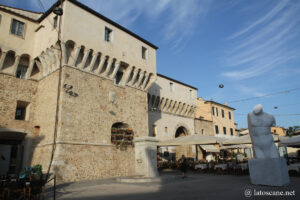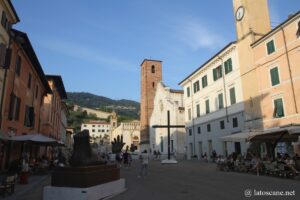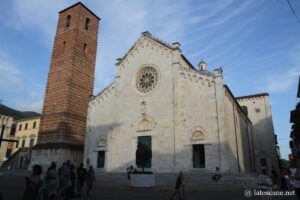The Versilia is a strip of territory in northern Tuscany, bordering the coast for almost 20 km, between its long sandy beaches to the west and the seaside coast, and towards the east the relief of the Apuan Alps. The hills of these heights are ideal for hiking and mountain biking, with their woods, olive trees and vineyards, some pretty villages, and in the plain the Massaciuccoli lake.
On the coast the main destinations are the resort and chic Forte dei Marmi, the artistic and upscale Pietrasanta and the family seaside resort Viareggio. In the hills you can discover Camaiore of Roman origin with its beautiful churches, Stazzema with its mines and forts, or Seravezza and its heritage of the Medici.
Versilia tourist map
If you see this after your page is loaded completely, leafletJS files are missing.
Forte dei Marmi
On the coast at the foot of the Apuan Alps, Forte dei Marmi is a seaside resort. Its name recalls that originally it was a fort of storage of the marble, in its « Fortino » around which the village developed.
Its beautiful golden beach attracts family and upscale tourism, characterized by its typical wooden cabins.
The village has in particular the Theatre of the historic Villa Bertelli, the historical centre with its luxury boutiques and the seafront with its chic restaurants and elegant villas.
Pietrasanta, capital of the Versilia
Between the coast and the relief of the Apuan Alps, Pietrasanta is the “Little Athens of Italy”, a chic village animated by many international artists such as Bottero. Contemporary works adorn the elegant historic centre which also boasts beautiful buildings and interesting museums, not to mention its many luxury boutiques, art galleries, wine bars and cellars or chic restaurants.
→ Read page about Pietrasanta



Viareggio
Viareggio is the city of a famous carnival of Italy and a popular seaside resort, between the side and its sandy beaches and the snowy peaks of the Apuan Alps.
The center is modern and pleasant for walking, the beautiful beach stretches from Darsena to the south becoming more and more wild until that of Lecciona near Torre del Lago and protected by a pine forest.
It was developed as a gateway from Lucca to the sea, founded in 1172 when the allies Lucca and Genoa opposed to Pisa built the fort with the Tower Matilda.
The town grew along the Burlamacca canal. The town was substantially developed only from the nineteenth century, then became a resort site at the time when Paolina Borghese, sister of Napoleon, stayed there.
Thus the Art Nouveau has beautiful examples in Viareggio, on the seafront or along the canal, especially the Gran Caffe Margherita or the Villa Argentina.
Viareggio preserves with its Civic Museums of Villa Paolina expressions of figurative arts, including art-deco, and a Maritime Museum dedicated to sailors.
Massarosa and Massaciuccoli lake
Massarosa is a sparse commune with several hamlets between the plain and the hills, an old Roman resort establishment, with vestiges of ancient thermal baths or a villa.
Beautiful houses were built from the fourteenth century to the nineteenth century and a circuit allows you to discover them. The best known is the Villa Baldini in Campignano frequented by the Bonaparte’s sister.
The Massaciuccoli Lake is an important site for migratory birds. Walkways and huts provide views of passing birds.
On its shore in Torre del Lago, the beautiful summer Festival Pucini, an opera festival, is held at the Gran Teatro Pucini.
Torre del Lago was indeed frequented by Giacomo Puccini and his fellow artists and the Casa-Museo Puccini kept alive in memory.
Camaiore
From Roman origin as Campus Major (meaning great plain) between Lucca and the Port of Luni, Camaiore is located at the foot of Mount Prana in the Apuan Alps.
Lucca developed the city in the Middle Ages and its present face dates back to this time.
Beautiful buildings can be found there, such as the 13th century Collegiate Church of Santa Maria Assunta with its baroque interior, the Church of San Lazzaro with its beautiful cloister or the Lombard Abbazia di San Pietro abbey founded around the 8th century.
The interesting Archaeological Museum is housed in the Tori Massoni Palace. The Museum of Sacred Art preserves furniture, objects or sacred paintings from the 14th to 16th centuries.
On the coast, Lido di Camaiore is a modern seaside resort with its long beach and promenade.
Stazzema
Stazzema covers a vast territory with several hamlets on the mountainous foothills, an area inhabited at least by a Ligurian people and which was exploited for its silver mines.
In the town, the clock tower dates from the eighteenth century, and the church of Santa Maria Assunta is remarkable, with its beautiful facade and 16th century bells.
The territory was defended by several fortifications that can be found around Torre dell’Argentiera, Monte Rocca, protecting the mines of Argentiera di Sant’Anna which keeps its old galleries.
Another interesting site is the Antiche Miniere di Calcaferro.
The Monte Croce is an opportunity for beautiful hikes with great panoramas.
In Levigliani, the Antro del Corchia is a gigantic karstic cave, with more than 50 km of galleries full of stalactites and stalagmites. The village has a museum dedicated to sacred objects in marble.
The National Park of Peace of Sant’Anna and the Resistance Museum recall the massacre of Sant’Anna di Stazzema, one of the worst committed by the Nazis in Italy.
Seravezza
The territory of Seravezza is that of majestic mountain foothills, woods and marble quarries, gateway to the Park of the Apuan Alps.
The historic center is rich thanks in particular to the Medici who stayed there regularly.
The Mediceo Palace, listed by UNESCO, was built by Cosimo I de’ Medici in the 16th century. It houses the Museum of Work and Popular Traditions of Versilia.
The nearby quarries, where Michelangelo used to stock up his goods, are visited. On the slopes of Folgorito Mount are remains of the Gothic Line, part of the German defensive system of the Second World War.
Proposal for guided tours and others in the region
Sources and links
- General informations : it.wikipedia.org
- Blogs and tourist portals : www.visittuscany.com, www.destinazioneterra.com
No Comments Yet